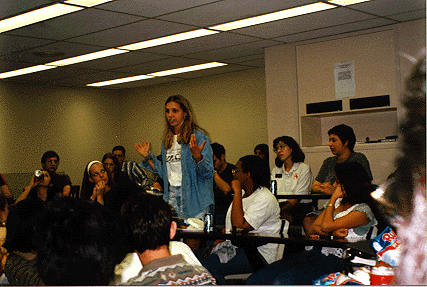
Spring/Summer 1999
Volume 6, Issue 2
Spring/Summer 1998
Volume
3, Issue 1
January 1995
Volume
2, Issue 4
October 1994
Volume
2, Issue 1
January 1994
Students Spend a Summer with a Scientist at Rice
The highly acclaimed Spend a Summer with a Scientist (SaS) program at Rice University provides opportunities for undergraduate and graduate students to participate in university activities and work for the summer under the guidance of center researchers. Directed by Richard Tapia, Noah Harding Professor and CRPC Director of Human Resources and Education, the SaS program exposes students to research and motivates them to attend or continue graduate school in science, mathematics, or engineering. SaS participants work with researchers from five computational science departments at Rice and from the Keck Center for Computational Biology, a collaboration between Rice, the Baylor College of Medicine, and the University of Houston.
"So far, I have worked with a professor, mentored high school students, visited Texas Instruments and NASA, and I'm ready for more," says Angelica Rodriguez, one of 17 college students participating in this year's program. A chemical engineering major at Rice, Rodriguez is working on a project that involves using fundamental laws of kinetics to determine the phytoremediation effects of hairy root cultures on trinitrotoluene (TNT), a contaminant. She has found that the interaction with professors, research scientists, and other SaS students greatly enhances her learning experience. "Once a week, Dr. Tapia holds a meeting for everyone and we talk about our projects' progress and issues dealing with minorities and women in graduate and undergraduate education and the workplace," she says. "I am now inspired to go on to graduate school."
The SaS students took time out from their research projects to do presentations for K-12 teachers, counselors, and principals attending the GirlTECH/MCSA workshop (see "Spotlight on Teachers") and acted as mentors to high school students in the South Texas Science Academy Intern Program and Milby Science Institute Summer Intern Program held at Rice in June (see "High School Students 'Experience College' in Summer Programs at Rice").
"A lot of the work I've done this summer has been teaching younger students about how interesting and important 'applied' math is," says Erin Kellam, who recently switched from a chemical engineering major to computational and applied math (CAAM) at Rice. "I especially like the applied part of computational and applied math -- it's easy to see where math is useful and is really the most fundamental tool." Kellam and fellow SaS student Samitra Seales are co-authoring projects initiated from the theses of two former graduate students at Rice. One is a revision and extention of a text introducing high school students to computational science and the other is a review and recommendations on a linear algebra masters thesis.
 |
For more information about the SaS program, see http://www.crpc.rice.edu/CRPC/SaS/
More SaS Photos
| Images by Ewasko | |||
Table of Contents